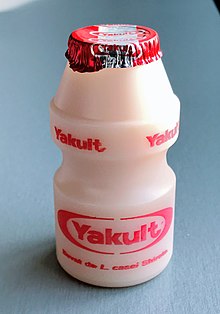Probiotik
Probiotik nyaéta mikroorganisme hirup anu dipromosikeun kalayan klaim hadé pikeun kaséhatan lamun dikonsumsi, umumna ku cara ngaronjatkeun atawa mulihkeun flora usus.[1][2] Probiotik sacara umum dianggap aman, tapi dina sababaraha kasus bisa ogé ngabalukarkeun gangguan.[3][4][5] Bukti kauntungan probiotik pikeun kaséhatan ukur saeutik, diandingkeun jeung aakuanana.

Watesan
éditLaporan Oktober 2001 ti Organisasi Kaséhatan World (WHO) netepkeun probiotik salaku mikroorganismeu hirup anu, "nalika dituang dina jumlah anu nyukupan, masihan mangpaat kaséhatan kanggo awakna." [6] Nuturkeun watesan ieu, grup kerja anu diayakeun ku Organisasi Kadaharan sareng Pertanian (FAO)/WHO dina bulan Méi 2002 ngaluarkeun Guidelines for the Evaluation of Probiotics in Food.[7]
Dina dahareun
éditKultur mikrobiologi probiotik hirup téh bagian ti produk susu ferméntasi, katuangan pérméntasi lianna, jeung tuangeun-probiotik.
Sababaraha produk fermentasi anu ngandung baktéri asam laktat (LAB) di antarana: sayuran acar,[8] kimci,[9] pao cai,[10] jeung sauerkraut;[11] produk kadelé kawas tempe, [12] miso, [13] jeung kecap,[14] sarta produk susu kayaning yogurt, kefir,[15] jeung susu mantéga. [16]
Tingali ogé
éditRujukan
édit- ↑ "Probiotics". National Health Service.
- ↑ "Probiotics: What You Need To Know". National Center for Complementary and Integrative Health, US National Institutes of Health. Diakses tanggal 10 November 2019.
- ↑ "Risk and safety of probiotics.". Clin Infect Dis 60 Suppl 2: S129–34. 2015. doi:10.1093/cid/civ085. PMC 4490230. PMID 25922398. Diarsipkan on 2016-08-11. Kesalahan: If you specify
|archivedate=, you must also specify|archiveurl=. http://cid.oxfordjournals.org/content/60/suppl_2/S129.long. Diakses pada 2016-06-04. - ↑ "Probiotics in critically ill children.". F1000Res 5: 407. 2016. doi:10.12688/f1000research.7630.1. PMC 4813632. PMID 27081478. http://www.pubmedcentral.nih.gov/articlerender.fcgi?tool=pmcentrez&artid=4813632.
- ↑ "Diet therapy for inflammatory bowel diseases: The established and the new.". World J Gastroenterol 22 (7): 2179–94. 2016. doi:10.3748/wjg.v22.i7.2179. PMC 4734995. PMID 26900283. http://www.pubmedcentral.nih.gov/articlerender.fcgi?tool=pmcentrez&artid=4734995.
- ↑ Schlundt, Jorgen. "Health and Nutritional Properties of Probiotics in Food including Powder Milk with Live Lactic Acid Bacteria" (PDF). Report of a Joint FAO/WHO Expert Consultation on Evaluation of Health and Nutritional Properties of Probiotics in Food Including Powder Milk with Live Lactic Acid Bacteria. FAO / WHO. Diarsipkan dari versi asli (PDF) tanggal October 22, 2012. Diakses tanggal 17 December 2012.
- ↑ "Guidelines for the Evaluation of Probiotics in Food" (PDF). Joint FAO/WHO Working Group on Drafting Guidelines for the Evaluation of Probiotics in Food, London, Ontario, Canada.
- ↑ "Fermented Vegetables" (PDF). Fermented Vegetables; In: Food Microbiology: Fundamentals and Frontiers, 4th Ed. Washington, DC: ASM Press. 2013. pp. 841–855. ISBN 978-1-55581-626-1. doi:10.1128/9781555818463.ch33. Diakses tanggal 19 May 2016.
- ↑ "The Depletion of Sodium Nitrite by Lactic Acid Bacteria Isolated from Kimchi". Journal of Medicinal Food 7 (1): 38–44. 2004. doi:10.1089/109662004322984680. PMID 15117551.
- ↑ "Fermentation of the Yugoslavian pickled cabbage". Applied Microbiology 10 (1): 86–9. 1962. PMC 1057814. PMID 14484853. http://www.pubmedcentral.nih.gov/articlerender.fcgi?tool=pmcentrez&artid=1057814.
- ↑ Friedman, Y; Hugenholtz, Jeroen; De Vos, Willem M.; Smid, Eddy J. (2006). "Safe use of genetically modified lactic acid bacteria in food. Bridging the gap between consumers, green groups, and industry". Electronic Journal of Biotechnology 9 (4): E49–55. doi:10.2225/vol9-issue4-fulltext-12. Diarsipkan on 14 August 2013. Kesalahan: If you specify
|archivedate=, you must also specify|archiveurl=. http://www.scielo.cl/scielo.php?script=sci_arttext&pid=S0717-34582006000400011&tlng=&lng=en&nrm=iso. Diakses pada 7 November 2007. - ↑ "Microbial analysis of Malaysian tempeh, and characterization of two bacteriocins produced by isolates of Enterococcus faecium". Journal of Applied Microbiology 92 (1): 147–157. 2002. doi:10.1046/j.1365-2672.2002.01509.x. PMID 11849339.
- ↑ Ehrlich, Steven D. "Lactobacillus acidophilus". University of Maryland Medical Center (UMMC). Diarsipkan dari versi asli tanggal 2015-09-11. Diakses tanggal 2015-09-17.
- ↑ "Lactic acid bacteria isolated from soy sauce mash in Thailand". Journal of General and Applied Microbiology 48 (4): 201–209. 2002. doi:10.2323/jgam.48.201. PMID 12469319.
- ↑ "Microbial ecology and quality assurance in food fermentation systems. The case of kefir grains application". Anaerobe 17 (6): 483–5. 2011. doi:10.1016/j.anaerobe.2011.03.014. PMID 21497663.
- ↑ "Fermented milks and milk products as functional foods--a review". Critical Reviews in Food Science and Nutrition 53 (5): 482–96. 2013. doi:10.1080/10408398.2010.547398. PMID 23391015.
| Artikel ieu mangrupa taratas, perlu disampurnakeun. Upami sadérék uninga langkung paos perkawis ieu, dihaturan kanggo ngalengkepan. |